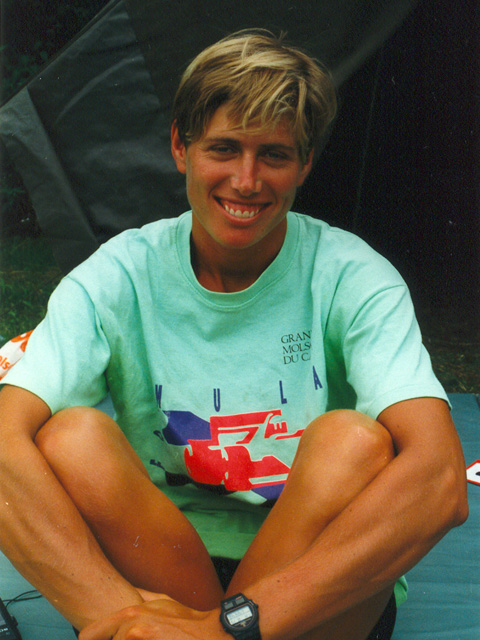Silken Laumann

Biographical information
| Roles | Competed in Olympic Games • Other |
|---|---|
| Sex | Female |
| Full name | Silken Suzette•Laumann (-Wallace) |
| Used name | Silken•Laumann |
| Born | 14 November 1964 in Mississauga, Ontario (CAN) |
| Measurements | 180 cm / 72 kg |
| Affiliations | Don Rowing Club, Mississauga (CAN) / VCRC, Victoria (CAN) |
| NOC |  Canada Canada |
| Medals | OG |
| Gold | 0 |
| Silver | 1 |
| Bronze | 2 |
| Total | 3 |
Biography
Silken Laumann is the greatest female rower ever produced by Canada. Her brilliant career has lacked only an individual sculling gold medal, but her failure to win gold at the 1992 Olympics may have been her finest moment in sport.
Laumann began her sports career as a runner but at age 17 turned to rowing along with her older sister, Danièle. They quickly advanced to the Canadian national team, and in 1984 at Los Angeles, teamed to win a bronze medal in the Olympic double sculls. After Danielle retired from the sport, Silken Laumann continued with other partners and began to scull a single as well. In 1985, she finished 4th at the World Championships in the single sculls. After a single sculls gold medal at the 1987 Pan-American Games, she returned to the doubles for the 1988 Olympics at Seoul, finishing 7th with Kay Worthington.
After the 1988 Olympics, Silken Laumann focused almost exclusively on the single sculls. She finished 7th at the 1989 World Championships and progressed to 2nd in 1990, before winning the singles World Championship in 1991. She dominated women’s sculling in that year, also winning international titles at Lucerne, San Diego, and Hazelwinkel (BEL) as part of the World Cup. With the 1992 Olympics on the horizon, Silken Laumann was the heavy favorite to win the gold medal in single sculls at Barcelona.
But shortly before the Barcelona Olympics, training at a lake in Essen, Germany on 16 May 1992, her dreams were shattered. Another scull and she collided and the impact drove a piece of the splashboard into Laumann’s leg. She sustained an open tibia fracture, with concurrent nerve damage, which permanently weakened her leg. She also lost skin and soft tissue that required multiple operations. She noted that “The muscles on the outside of my right leg were peeled back and hanging down to the ankle … the doctors thought I would never row again.” Her gold medal plans seemed doomed but she refused to quit. Pushing herself into rehab, she determined to compete at Barcelona, even if she was at less than her previous dominant self, “I will not forget getting back into the shell. I love the sport so much, but I didn’t fully realize it until I got out there. I just sat in the boat for a time, pushed off the dock, then started to cry. It was wonderful.”
Laumann did not win the single sculls at Barcelona, but she did medal, finishing 3rd behind her arch-rival, Romania’s Elisabeta Lipa. Olympic chronicler, Bud Greenspan, said it best, “Canada won four gold medals and one bronze medal in rowing at Lake Banyoles. Let the word go out that on this day the bronze medal shone as brightly in the Barcelona sun as any of the gold.”
Laumann’s career did not end at Barcelona. Still with nerve and muscle damage to her injured leg, she finished 2nd at the Worlds in 1995 in the singles, and repeated that finish for an Olympic silver medal at Atlanta in 1996 before retiring. But it was her courageous performance at Barcelona for which she will always be best remembered.
Results
| Games | Discipline (Sport) / Event | NOC / Team | Pos | Medal | As | |
|---|---|---|---|---|---|---|
| 1984 Summer Olympics | Rowing |  CAN CAN |
Silken Laumann | |||
| Double Sculls, Women (Olympic) | Danièle Laumann | 3 | Bronze | |||
| 1988 Summer Olympics | Rowing |  CAN CAN |
Silken Laumann | |||
| Double Sculls, Women (Olympic) | Kay Worthington | 7 | ||||
| 1992 Summer Olympics | Rowing |  CAN CAN |
Silken Laumann | |||
| Single Sculls, Women (Olympic) | 3 | Bronze | ||||
| 1996 Summer Olympics | Rowing |  CAN CAN |
Silken Laumann | |||
| Single Sculls, Women (Olympic) | 2 | Silver |
Other participations
| Games | Role | NOC | As | |
|---|---|---|---|---|
| 1992 Summer Olympics | Flagbearer at the Closing Ceremony |  CAN CAN |
Silken Laumann |
Olympic family relations
- Sister of Danièle Laumann
- Wife (divorced) of John Wallace
Special Notes
- Listed in Olympians Who Won a Medal at the Summer Pan American Games (2–0–0 1987 Indianapolis ROW gold: single sculls; 1995 Mar del Plata ROW gold: single sculls)
- Listed in Olympians Who Won a Medal at the Summer Universiade (0–0–1 1987 Zagreb ROW bronze: single sculls)